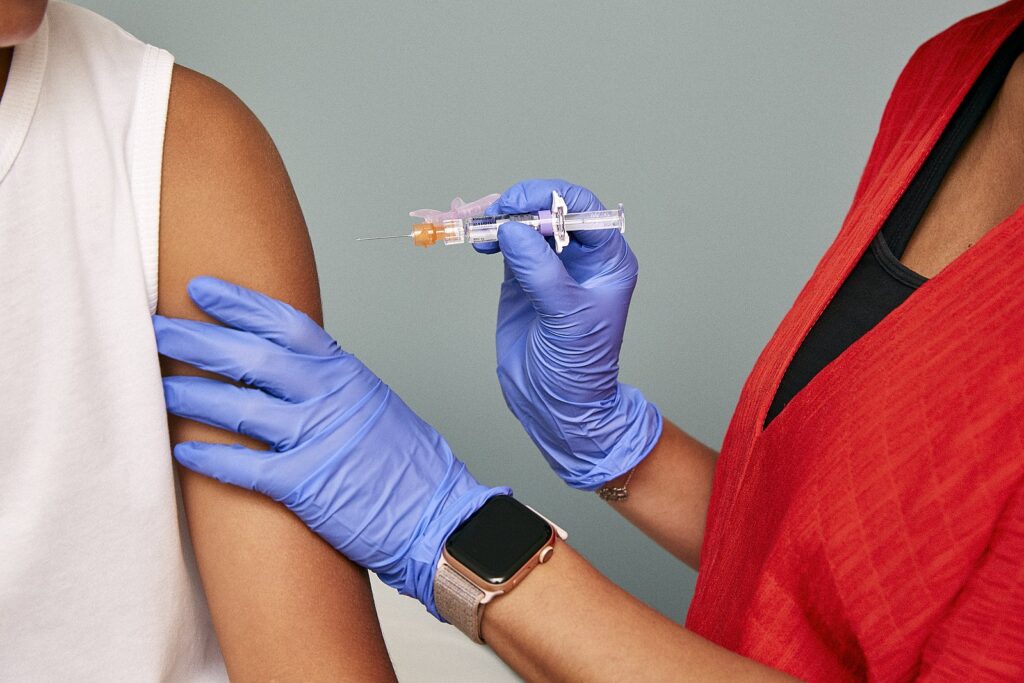The new COVID-19 vaccines bring promising new technology—but new data reveals that people of color are expressing vaccine hesitancy in significant numbers.

Reports of the new COVID vaccines headed toward possible local, national and global distribution provide many with a light at the end of the tunnel-vision.
The leading vaccine candidates have publicly announced their efficacy rates. Two of the new drugs have an efficacy rate of around 95 percent, and the other around 70 percent. The Federal Drug Administration will announce approval of vaccines after a December 10 meeting.
As a community health nurse, and Filipino-American, I know that the light and tunnel analogy are reserved for those who see the world through a different lens than I do.
Any benefits offered by a vaccine could be undermined if enough people decline to take it, and emerging data reveals that people of color are expressing vaccine hesitancy in significant numbers: A survey by Pew Research Center revealed that 57 percent of Black Americans and 53 percent of Hispanic Americans believe that the risks outweigh the benefits of receiving new drugs.
A national survey of 21,000 social media users nationwide also found that vaccine hesitancy and COVID-19 misinformation did not fall along political party lines, but along racial ones. The results showed that people of color, particularly Black Americans under the age of 45, were more likely to believe and share false claims posted on social media about the COVID-19 crisis, and were less likely to seek the COVID-19 vaccine when it becomes available.
This is profoundly unfortunate because COVID disproportionately affects minority communities and people of color resulting in larger spread, more hospitalizations, and poorer outcomes. A recent analysis from the Washington Post reported that Black Americans are 37 percent more likely to die from COVID-19 than non-Hispanic whites; Native Americans at 26 percent; Asian Americans at 53 percent and Hispanic Americans at 16 percent.
Minority nurses are also being disproportionately affected. About 58 percent of nurses who have died of COVID are people of color—30 percent are Filipino-American.
What’s worse is that when this data emerged, those who work in the medical community were not surprised. In nursing and medical school, curriculum covers the fact that health disparities are linked to social determinants of health.
Data reveals people of color are more likely to work lower wage jobs, lack access to health care, experience toxic stress and discrimination, and often live in communities without healthful infrastructure.
Complicated by the legacy of racism in health care, people of color are more likely to suffer from chronic diseases such as heart disease, lung disease, and diabetes.
I didn’t just train in these facts. I grew up in them.
When I was a child, my household had aunts, uncles, grandparents and cousins, all living together under one roof. When one fell ill, vapor rub was liberally applied and rice chicken soup was doled out no matter what the symptoms.
This was done for equal parts cultural and economic reasons.
As a working class family, we were underinsured and access to health care was a luxury. Filipinos like many minority groups, place a heavy emphasis on large familial networks. As new immigrants trying to find their footing in a new country, my parents thought it best to pool resources and lean on their community.
My professional experience is also reflected in the statistics: 43 percent of those deemed essential workers are people of color, and often live in housing dense with large networks of extended family.

The U.S. Has a Long History of Racism in Health Care
The health gap is not new. The United States maintains a long history marred with racial discrimination within health care, and unethical aberrations in scientific experimentation. The most notorious example of this is the Tuskegee Syphilis Study, where Black men were misled to believe they were receiving “free government health care” when in fact they were unwittingly participating in a study that actively withheld life-saving treatment.
It is significant to note that female Black bodies were not spared, as foundational gynecological knowledge was formed by the exploitation of Black female slaves, and the unjust harvesting of the cell that revolutionized the scientific world came from an unconsenting Black woman named Henrietta Lacks.
These transgressions were not relegated to state-side. Unscrupulous scientific experimentation was deployed on American military bases in the Philippines, where doctors injected Filipinos with the bubonic plague.
In Guatemalan prisons, U.S. researchers exploited female prostitutes to spread syphilis to the prisoners.
Black, Indigenous and people of color (BIPOC) and minority group Americans have suffered greatly in the name of medical advancement throughout history and the legacy of that racism exists today.
In health care training, disease presentations and detection are typically taught on white bodies, leaving darker-skinned patients undiagnosed and untreated with sometimes life-threatening illnesses. In hospitals, Black Americans and other minority groups suffer higher mortality rates.
Unsurprisingly, BIPOC harbor an inherent distrust of the medical industrial complex.
Vaccine Distrust High Among the Very Groups That Need it Most
The new COVID-19 vaccines bring promising new technology—but among people of color for whom the virus disproportionately affects, it’s a tough sell.
This is why it is imperative for grassroots, community-based efforts to dispel COVID-19 and vaccine misinformation. Community outreach is most effective when it comes from within the community itself, and dispelling misinformation that runs rampant on social media is the first step in combating the viral spread among communities of color.
The recruitment of existing social structures that run deep within a community—not just health care institutions—but schools, places of worship and community programs, are essential in changing the hearts and minds of people of color.
These trusted community institutions must bear the responsibility to reach out to the most vulnerable populations and provide insight, guidance and factual information about the COVID vaccines.
I sent a text message to my family to find out if they’d be willing to receive the COVID-19 vaccine as soon as it becomes available. All five of them said they were too afraid to be among the group to receive it first. My brother, who lives with his in-laws in a downstairs unit in San Francisco responded, “I’d want to see the data first. My short answer is ‘maybe.’”
I then asked him what he would need to feel less hesitant, and he said, “Let’s put it this way: If you take it, I’ll take it.”
To fellow health care workers and community leaders, know that so many people are looking for answers. It is critical to guide them down that tunnel to a small light on the other side.
You may also like:





